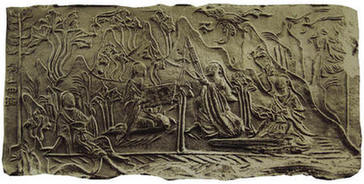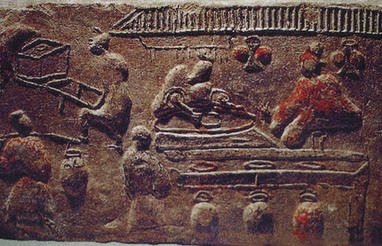The Art of Bricks and Tile Ends
The Qin Dynasty (221-206 B.C.) had four imperial polymath councilors who were highly revered by the imperial court for their intelligence and resourcefulness. Since they would not go along with Emperor Qinshihuang's tyranny, they resigned together and lived a secluded life on Shangluo Mountain (Shang Mountain). The hair on all their heads turned white-gray, earning them the collective epithet the "Four White-haired Hermits."
The "Four White-haired Hermits" and an Engraved Brick
 |
| A brick with an engraved pattern: Four White-haired Hermits of South Mountain. |
After Liu Bang brought down the Qin and established the Han Dynasty (206 B.C.-A.D.220), he sent for the "Four White-haired Hermits" to help him rule the country, but they declined.
In his late years, Liu Bang grew dissatisfied with his crown prince Liu Ying, born to Empress Lü and whom he described as "not of my kind." In contrast he increasingly described another son, Liu Ruyi, born to his favorite concubine Qi, as "of my kind." He intended to depose Liu Ying and replace him with Liu Ruyi. Empress Lü went to resourceful Zhang Liang for ideas. Zhang said that the emperor highly admired the talent of the "Four White-haired Hermits," though he could not get them to serve him, and advised the empress to spare no money or effort in winning over the four wise men to the crown prince's side. The empress was able to successfully do this, and the "Four White-haired Hermits" became the crown prince's councilors.
Once the crown prince attended an imperial banquet, and the "Four White-haired Hermits" stood conspicuously by his side, silver-haired, solemn and dignified. Liu Bang asked who they were. When he learned of their names, he was surprised, asking why they would rather help his son than work for him. One of the four answered, "Your Majesty belittles learned men and often scolds them. We are afraid of such humiliation, so we hide in the mountains. We've learned that the crown prince is benevolent and righteous and respects and appreciates the learned, so we've come to him."
Born of, and growing up among the lower class, Liu Bang developed some vulgar habits and despised the learned and Confucianism. Once he urinated into a Confucian scholar's hat to show his contempt. So he could not rebuff the criticism. Later, he said to Concubine Qi, "I had intended to remove the crown prince, but now he has grown fully-fledged with the help of the four men, I can't do it any more." He never raised the issue again, and Liu Ying finally became Emperor Huidi.
After the crown prince succeeded to the throne, the "Four White-haired Hermits" left him and returned to their life of seclusion. When they died, they were buried at the foot of their mountain home. Emperor Huidi sent 3,000 imperial troops, each carrying five kilos of earth from Chang'an (the Han capital), to add on their tomb mounds, and he wrote epitaphs for them. In the centuries that followed, stories of the four men became widely known, and poetry, prose and other historic writings mentioned them either as the "Four White-haired Hermits of Shang Mountain" or the "Four White-haired Hermits of South Mountain." An engraved brick unearthed in 1958 from a tomb of the Northern and Southern Dynasties (420-589) in Henan's Dengxian County supports these ancient records, as it is entitled, "The Four White-haired Hermits of South Mountain." Since Mount Shang was to the south of Chang'an, it is believed that it was also known as South Mountain, as ancient literati were wont to describe peaks by their geographical position to add a poetic tinge to their writing.
Engraved Bricks
 |
| A pattern depicting liquor brewing. |
The practice of engraving patterns on bricks used for construction originated in the late Warring States Period in the third century B.C. It reached its zenith in the Han Dynasty, and remained popular as late as the Northern and Southern Dynasties period. The patterns were either shallow reliefs created using wooden molds, or incised or raised outlines carved on bricks before they were kilned. Some of them were also painted in red, green and white.
Such bricks were used in palace and tomb construction. There were larger, hollow bricks, as well as smaller solid ones. Motifs include production and living activities such as plowing, sowing, harvesting, herding, banquets, and entertainment. There are also depictions of mythological scenes, legendary figures and natural phenomena.
Aristocratic Woman on an Outing was unearthed in the same tomb chamber as that of The Four White-haired Hermits of South Mountain. The slender noble women and maids wear high coiffures and flowing dresses that reach to their feet. According to historical records, high coiffures appeared in the Han Dynasty, and were widely adopted by noble women in the Northern and Southern Dynasties. In the fifth century ordinary women also started to copy such hairstyles, sometimes wearing them more than a foot high. Since such coiffures were difficult to achieve and prevented daily dressing, some women wore wigs instead. By the Song Dynasty (960-1279), wigs became so popular that makers and dealers had appeared in many large cities.
Engraved bricks have been unearthed in many parts of China, mostly in Sichuan, Henan, Jiangsu, Shaanxi and Shanxi provinces. Henan and Sichuan are best known for bricks of the Han Dynasty, the former having the largest number of hollow ones and the latter yielding mainly solid bricks. Each brick usually bears one composition.
The engraved Han bricks from Sichuan come in a wide variety of motifs, but stand out for their depictions of production activities. The best known is Harvesting, Fishing and Hunting, which in contemporary times was printed on a souvenir stamp. The composition includes two parts: in the upper section two hunters stretch their bows to full tension as birds fly above and fish swim below; the lower part has five human figures bending over harvesting work. A figure to their left is carrying food boxes on a shoulder pole. Such bricks have not been unearthed in other areas. Since the composition is molded, the same motif has also been found on other bricks. One of them bears the footprint of a dog, apparently left by a wondering animal when the brick was drying.
|
